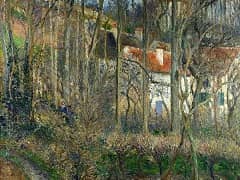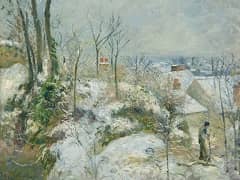Lordship Lane Station, Dulwich, 1871 by Camille Pissarro

This scene of the newly built Lordship Lane Station, which served the crowds visiting exhibitions at Crystal Palace, was painted on Pissarro's first visit to London. In 1870 he brought his family to England to escape the Eranco-Prussian War, and they stayed with his half-sister in Lpper Norwood just outside the city. Pissarro had found himself in a difficult situation when the war broke out: he was unable to fight with the French as he still retained Danish nationality, and it soon became clear that his house at Louveciennes was in the path of the invading Prussians. Abandoning over 1500 paintings, the body of his early work, he first fled with his family to Montfoucault in Britanny to take refuge with his great friend, the painter Ludovic Piettc, and from there in the autumn they traveled over to England.
Later in his life Pissarro was to visit London regularly, and he enjoyed it, but he begrudged this first visit, writing to his friend Theodore Duret in June 1871: "I am here for only a very short time. I count on returning to France as soon as possible... Here there is no art; everything is a question of business." Even so this London visit gave him a chance to reassess his work in the light of Constable and Turner , whom he viewed with Monet, also in London to escape the war.
The structure of the painting relies on a traditional compositional device, that of receding parallel lines which lead the eye into the picture space. Pissarro has effectively reversed the process, however, by depicting the train steaming towards the viewer, against the natural "entry" into the composition, but he ensures that the eye is taken back towards the rows of newly built houses on the left by using the fence, with its strong browns and blacks, to direct the way. Similarly the strong, swift grey line of paint on the brow of the bank prevents the eye from leaving the picture on the right.
















